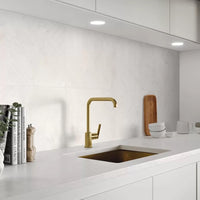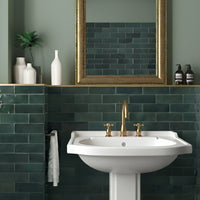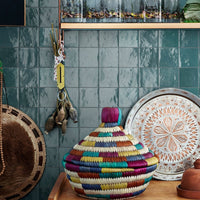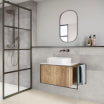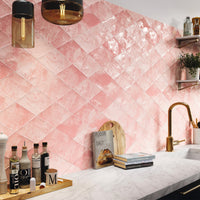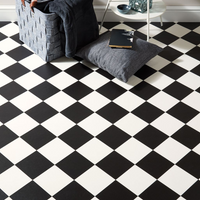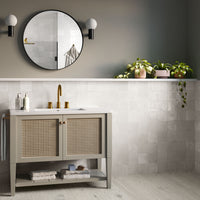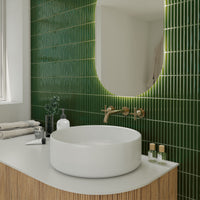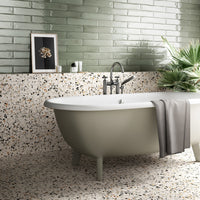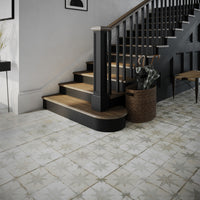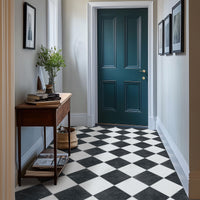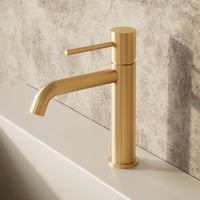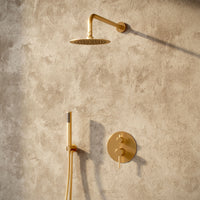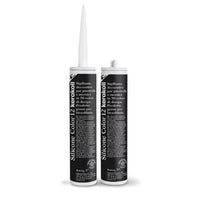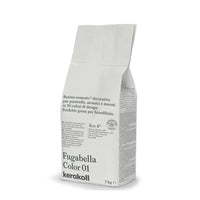If you’re thinking about updating your home you’ve probably already heard of porcelain tiles but you might be a little confused about what exactly they are.
Well don’t worry, as our name suggests we’re big fans or porcelain tiles and know a thing or two about them. This blog post gives a quick introduction into the wonders of these tiles – what makes them so good, where you can use them and why they’re so much better than natural stone, carpet and ceramic tiles.
Porcelain versus ceramic
You’re probably familiar with ceramic tiles and it’s pretty likely that you may already have some in your home. Porcelain is a particular type of ceramic tile – one that’s denser, harder and absorbs far less water. Porcelain tiles are produced by mixing together refined clay and minerals, compacting the mixture into moulds and firing these at incredibly high temperatures.
To qualify as porcelain, a tile must be “fully vitrified with a water absorption of 0.5% or less”. Sounds great, right?
I have no idea what you’re talking about…
As the porcelain mixture is fired, it ‘vitrifies’ and transforms into a glass-like material. This makes it extremely hard and dense, in addition to a whole host of other desirable properties. Let’s take a closer look at some of these:
– Extremely resistant to wear and tear
– Resistant to stains and chemicals
– Easy to maintain
– Virtually impervious to water
– Incredibly cost effective
Use pretty much anywhere
As a floor covering, porcelain is pretty perfect as it combines the versatility of tiles, the warmth of wood and the ease of laminates. You can use the same tile in pretty much any setting in any room in your home – as a feature wall behind your bath, your new wetroom floor or in your open plan kitchen and living room.
Most of our porcelain tiles can also be used in light commercial applications such as shops, offices, bars and restaurants. Some are so hard wearing that they can be used on factory floors!
There’s also a variety of different finishes available such as matt, textured, anti-slip and polished.
What shapes and sizes do porcelain tiles come in?
Porcelain tiles are a bit like the pick and mix at the cinema – there’s something for everyone. There’s eye-catching hexagon tiles, large format slabs and innovative porcelain planks which are one of the hottest trends for 2014.
Tiles get bigger and bigger every year – not so long ago a 60 x 60 cm tile was by far the biggest size available. Our Forma range is available in an 80 x 80 cm slab and we’ve recently added some new plank tiles that are a staggering 120 cm long.
However, bigger isn’t always better and plenty of new tiles are getting smaller. Take a look at these funky new Italian mosaics. They’re the smallest mosaics you can find and measure a tiny 1 x 1 cm!
Incredibly realistic designs
Not so long ago, most tiles seemed to come in white, off white or off-off white.
Thankfully, the tile world has moved on and visiting a tile exhibition is like walking round a fashion show. There’s distressed woods here, shades of cool grey there and on trend decorative tiles all over.
In recent years tile manufacturers have invested heavily in the latest ‘inkjet printing’ machinery which is basically a giant version of your desktop printer. This prints a high definition image onto the surface of the porcelain tile and has opened up a whole new world of design possibilities. The end results are incredible – for example, a marble effect tile is pretty much indistinguishable from the real natural stone. What’s really exciting is the way tiles can now replicate exotic natural materials – such as rare tropical woods – without a single tree having to be chopped down.
Let’s dispel a few myths about porcelain
Hopefully by now you’re thinking that porcelain is pretty wonderful, right?
Good!
However, as porcelain tiles are still relatively new some there are a couple of misconceptions about them. Here’s are some of the more prominent:
Porcelain tiles are cold
It was a pretty warm weekend in Manchester and yesterday, my kitchen tiles felt so refreshing underfoot. Unfortunately, I know the weather in the UK will be significantly cooler in a few months time and so too will my tiles…
… and that’s where the magic that is underfloor heating steps is. Not only does underfloor heating take the chill off your tiles on a cold morning, it can also be used as the sole heating source in your room. So in your new kitchen, lay some electric mats under your tiles and you can lose those ugly radiators! Porcelain is a great conductor so you’ll get a nice, radiant heat with no cold spots.
They’re difficult to install
Not at all! Installing porcelain is pretty much the same as installing ceramic tiles. You’ll need a cutter with a diamond blade but unlike natural stone, you shouldn’t need to use a messy wet cutter for straight cuts or seal and re seal tiles. Part of the misconception stems from the fact that porcelain tiles require diamond tipped drill bits to drill any holes but these are readily available and inexpensive.
All competent tilers should be comfortable working with porcelain (if they’re not, be wary) and if you’re a competent DIY-er then you should have no problems at all. As with all building work, the more preparation undertaken, the better the end result
Thin porcelain tiles aren’t as hard
It’s easy to assume that the thicker the tile, the stronger it is. However, looks can be deceiving! While most porcelain tiles measure up around the 10 mm thickness mark, some are considerably thinner. Don’t be worried that these tiles won’t stand up to the stresses of daily living – all of our tiles are produced to European standards and have to pass stringent tests on strength and wear.
For example, our Forest wood effect planks measure a pretty slim 8 mm thickness but have all the strength of their heavier siblings and they’ve been used to tile plenty of commercial foyers, restaurants, shops and As an aside, some of our Italian manufacturers now produce wafer thin tiles – just 4 mm!
The environmental benefits of porcelain
Last – but certainly not least – porcelain tiles have many environmental advantages over their counterparts.
Many porcelain tiles contain recycled content such as waste glass bottles and redundant TV screens. Due to the manufacturing processes involved, they contain extremely low or zero levels of VOCs – Volatile Organic Compounds. These are harmful to health and are present in many laminate, carpets and engineered floors.
As I mentioned before, many porcelain tiles perfectly replicate natural materials such as stones and timber. Many prized woods are endangered species and the porcelain version ensures that no rare trees have to be felled.
Instead, our porcelain tiles are made in safe, regulated factories in Italy and Spain. Our partners are committed to preserving the environments and investing in energy saving technology. Compare this to the natural stone industry where mountainsides are blasted to smithereens, labour laws may be dubious and polluted water is allowed to run off into steams.
If you have any questions at all don’t forget to get in touch!
